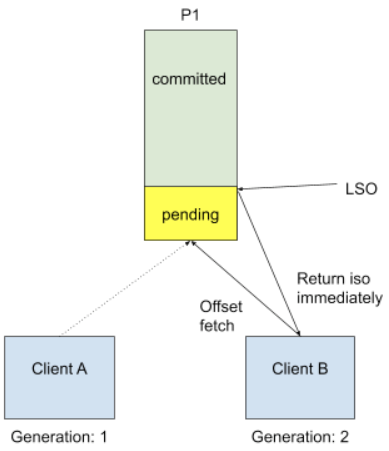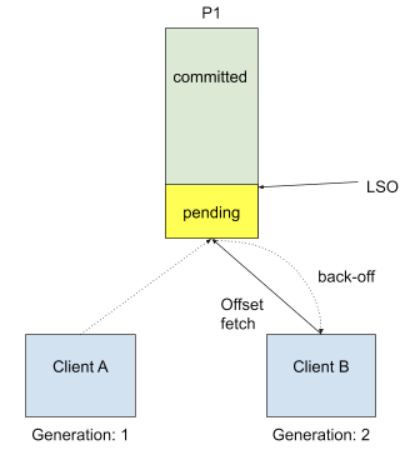| Table of Contents |
|---|
Status
Current state: Under discussion
...
Please keep the discussion on the mailing list rather than commenting on the wiki (wiki discussions get unwieldy fast).
Motivation
Exactly once semantics (EOS) provides transactional message processing guarantees. Producers can write to multiple partitions atomically so that either all writes succeed or all writes fail. This can be used in the context of stream processing frameworks, such as Kafka Streams, to ensure exactly once processing between topics.
...
This architecture does not scale well as the number of input partitions increases. Every producer come with separate memory buffers, a separate thread, separate network connections. This limits the performance of the producer since we cannot effectively use the output of multiple tasks to improve batching. It also causes unneeded load on brokers since there are more concurrent transactions and more redundant metadata management.
Proposed Changes
We argue that the root of the problem is that transaction coordinators have no knowledge of consumer group semantics. They simply do not understand that partitions can be moved between processes. Currently transaction coordinator uses the initTransactions API currently in order to fence producers using the same transactional Id and to ensure that previous transactions have been completed. We propose to switch this guarantee on group coordinator instead.
Let's take a look at a sample exactly-once use case, which is quoted from KIP-98:
| Code Block | ||||||
|---|---|---|---|---|---|---|
| ||||||
public class KafkaTransactionsExample {
public static void main(String args[]) {
KafkaConsumer<String, String> consumer = new KafkaConsumer<>(consumerConfig);
// Note that the ‘transactional.id’ configuration _must_ be specified in the
// producer config in order to use transactions.
KafkaProducer<String, String> producer = new KafkaProducer<>(producerConfig);
// We need to initialize transactions once per producer instance. To use transactions,
// it is assumed that the application id is specified in the config with the key
// transactional.id.
//
// This method will recover or abort transactions initiated by previous instances of a
// producer with the same app id. Any other transactional messages will report an error
// if initialization was not performed.
//
// The response indicates success or failure. Some failures are irrecoverable and will
// require a new producer instance. See the documentation for TransactionMetadata for a
// list of error codes.
producer.initTransactions();
while(true) {
ConsumerRecords<String, String> records = consumer.poll(CONSUMER_POLL_TIMEOUT);
if (!records.isEmpty()) {
// Start a new transaction. This will begin the process of batching the consumed
// records as well
// as an records produced as a result of processing the input records.
//
// We need to check the response to make sure that this producer is able to initiate
// a new transaction.
producer.beginTransaction();
// Process the input records and send them to the output topic(s).
List<ProducerRecord<String, String>> outputRecords = processRecords(records);
for (ProducerRecord<String, String> outputRecord : outputRecords) {
producer.send(outputRecord);
}
// To ensure that the consumed and produced messages are batched, we need to commit
// the offsets through
// the producer and not the consumer.
//
// If this returns an error, we should abort the transaction.
sendOffsetsResult = producer.sendOffsetsToTransaction(getUncommittedOffsets());
// Now that we have consumed, processed, and produced a batch of messages, let's
// commit the results.
// If this does not report success, then the transaction will be rolled back.
producer.endTransaction();
}
}
}
} |
The primary change going on here is that we need to be able to Notice that
The case will be changed in the new fetch offset design.
Public Interfaces
The main addition of this KIP is a new variant of the current initTransactions API which gives us access to the consumer group states, such as member.id and generation.id.
...
The new InitProducerId API accepts either a user-configured transactional Id or a consumer group Id and a generation id. When a consumer group is provided, the transaction coordinator will honor consumer group id and allocate a new producer.id every time initTransaction is called.
Fencing zombie
A zombie process may invoke InitProducerId after falling out of the consumer group. In order to distinguish zombie requests, we include the consumer group generation. Once the coordinator observes a generation bump for a group, it will refuse to handle requests from the previous generation. The only thing other group members can do is call InitProducerId themselves. This in fact would be the common case since transactions will usually be completed before a consumer joins a rebalance.
...
When set to true and exactly-once is turned on, Kafka Streams application will choose to use single producer per thread.
Fencing for upgrades
And to avoid concurrent processing due to upgrade, we also want to introduce an exception to let consumer back off:
...
Will discuss in more details in Compatibility section.
Example
Below we provide an example of a simple read-process-write loop with consumer group-aware EOS processing.
...
- Consumer group id becomes a config value on producer.
- Generation.id will be used for group coordinator fencing.
- We no longer need to close the producer after a rebalance.
Compatibility, Deprecation, and Migration Plan
This is a server-client integrated change, and it's required to upgrade the broker first with `inter.broker.protocol.version` to the latest. Any produce request with higher version will automatically get fenced because of no support. If this is the case on a Kafka Streams application, you will be recommended to unset `CONSUMER_GROUP_AWARE_TRANSACTION` config as necessary to just upgrade the client without using new thread producer.
We need to ensure 100% correctness during upgrade. This means no input data should be processed twice, even though we couldn't distinguish the client by transactional id anymore. The solution is to reject consume offset request by sending out PendingTransactionException to new client when there is pending transactional offset commits, so that new client shall start from a clean state instead of relying on transactional id fencing. Since it would be an unknown exception for old consumers, we will choose to send a COORDINATOR_LOAD_IN_PROGRESS exception to let it retry. When client receives PendingTransactionException, it will back-off and retry getting input offset until all the pending transaction offsets are cleared. This is a trade-off between availability and correctness, and in this case the worst case for availability is just waiting transaction timeout for one minute which should be trivial one-time cost during upgrade only.
Rejected Alternatives
- Producer Pooling:
- Producer support multiple transactional ids:
- Tricky rebalance synchronization:
- We could use admin client to fetch the inter.broker.protocol on start to choose which type of producer they want to use. This approach however is harder than we expected, because brokers maybe on the different versions and if we need user to handle the tricky behavior during upgrade, it would actually be unfavorable. So a hard-coded config is a better option we have at hand.
- We have considered to leverage transaction coordinator to remember the assignment info for each transactional producer, however this means we are copying the state data into 2 separate locations and could go out of sync easily. We choose to still use group coordinator to do the generation and partition fencing in this case.
...

